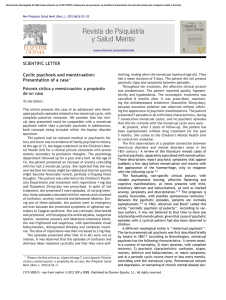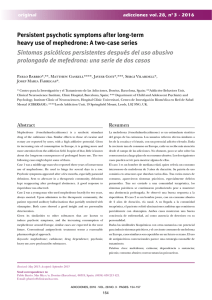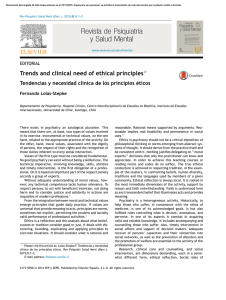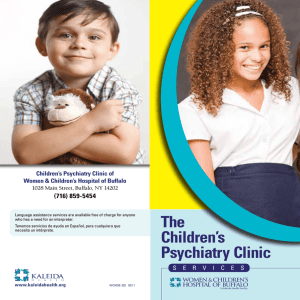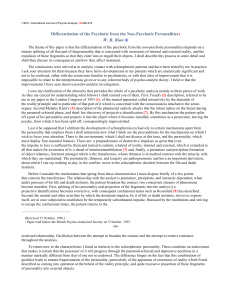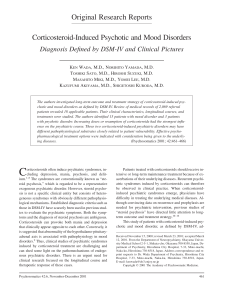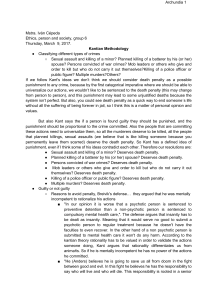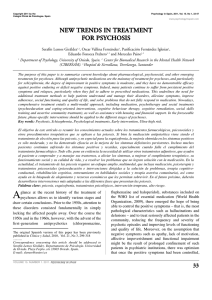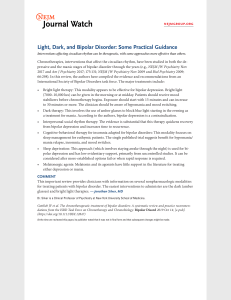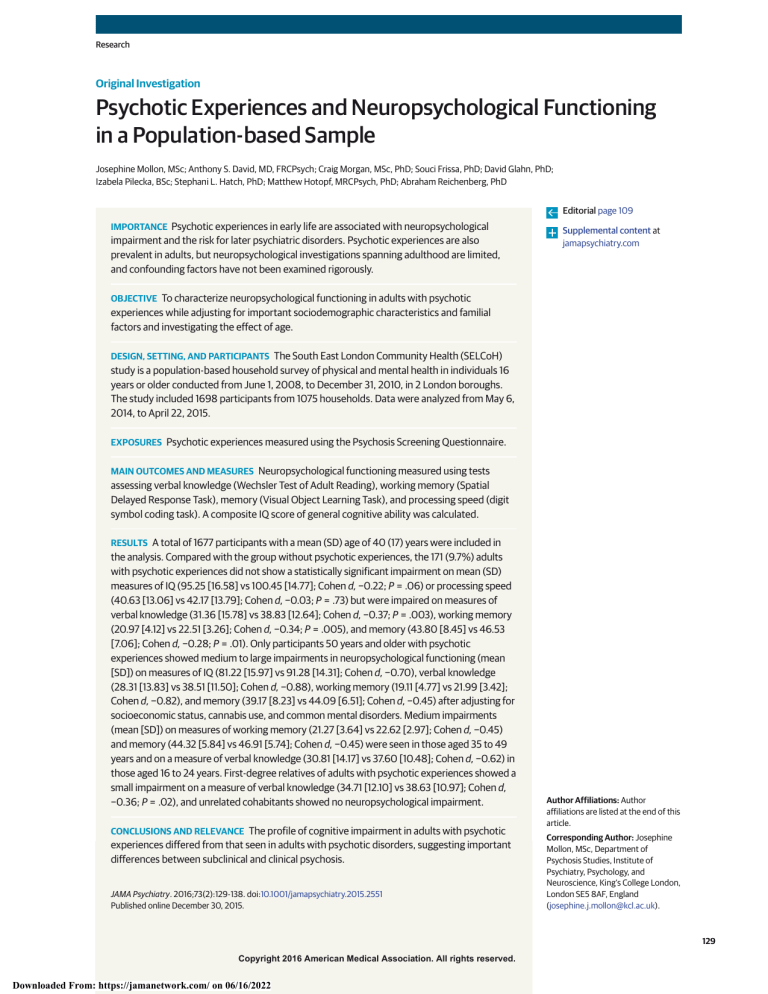
Research Original Investigation Psychotic Experiences and Neuropsychological Functioning in a Population-based Sample Josephine Mollon, MSc; Anthony S. David, MD, FRCPsych; Craig Morgan, MSc, PhD; Souci Frissa, PhD; David Glahn, PhD; Izabela Pilecka, BSc; Stephani L. Hatch, PhD; Matthew Hotopf, MRCPsych, PhD; Abraham Reichenberg, PhD Editorial page 109 IMPORTANCE Psychotic experiences in early life are associated with neuropsychological impairment and the risk for later psychiatric disorders. Psychotic experiences are also prevalent in adults, but neuropsychological investigations spanning adulthood are limited, and confounding factors have not been examined rigorously. Supplemental content at jamapsychiatry.com OBJECTIVE To characterize neuropsychological functioning in adults with psychotic experiences while adjusting for important sociodemographic characteristics and familial factors and investigating the effect of age. DESIGN, SETTING, AND PARTICIPANTS The South East London Community Health (SELCoH) study is a population-based household survey of physical and mental health in individuals 16 years or older conducted from June 1, 2008, to December 31, 2010, in 2 London boroughs. The study included 1698 participants from 1075 households. Data were analyzed from May 6, 2014, to April 22, 2015. EXPOSURES Psychotic experiences measured using the Psychosis Screening Questionnaire. MAIN OUTCOMES AND MEASURES Neuropsychological functioning measured using tests assessing verbal knowledge (Wechsler Test of Adult Reading), working memory (Spatial Delayed Response Task), memory (Visual Object Learning Task), and processing speed (digit symbol coding task). A composite IQ score of general cognitive ability was calculated. RESULTS A total of 1677 participants with a mean (SD) age of 40 (17) years were included in the analysis. Compared with the group without psychotic experiences, the 171 (9.7%) adults with psychotic experiences did not show a statistically significant impairment on mean (SD) measures of IQ (95.25 [16.58] vs 100.45 [14.77]; Cohen d, −0.22; P = .06) or processing speed (40.63 [13.06] vs 42.17 [13.79]; Cohen d, −0.03; P = .73) but were impaired on measures of verbal knowledge (31.36 [15.78] vs 38.83 [12.64]; Cohen d, −0.37; P = .003), working memory (20.97 [4.12] vs 22.51 [3.26]; Cohen d, −0.34; P = .005), and memory (43.80 [8.45] vs 46.53 [7.06]; Cohen d, −0.28; P = .01). Only participants 50 years and older with psychotic experiences showed medium to large impairments in neuropsychological functioning (mean [SD]) on measures of IQ (81.22 [15.97] vs 91.28 [14.31]; Cohen d, −0.70), verbal knowledge (28.31 [13.83] vs 38.51 [11.50]; Cohen d, −0.88), working memory (19.11 [4.77] vs 21.99 [3.42]; Cohen d, −0.82), and memory (39.17 [8.23] vs 44.09 [6.51]; Cohen d, −0.45) after adjusting for socioeconomic status, cannabis use, and common mental disorders. Medium impairments (mean [SD]) on measures of working memory (21.27 [3.64] vs 22.62 [2.97]; Cohen d, −0.45) and memory (44.32 [5.84] vs 46.91 [5.74]; Cohen d, −0.45) were seen in those aged 35 to 49 years and on a measure of verbal knowledge (30.81 [14.17] vs 37.60 [10.48]; Cohen d, −0.62) in those aged 16 to 24 years. First-degree relatives of adults with psychotic experiences showed a small impairment on a measure of verbal knowledge (34.71 [12.10] vs 38.63 [10.97]; Cohen d, −0.36; P = .02), and unrelated cohabitants showed no neuropsychological impairment. CONCLUSIONS AND RELEVANCE The profile of cognitive impairment in adults with psychotic experiences differed from that seen in adults with psychotic disorders, suggesting important differences between subclinical and clinical psychosis. JAMA Psychiatry. 2016;73(2):129-138. doi:10.1001/jamapsychiatry.2015.2551 Published online December 30, 2015. Author Affiliations: Author affiliations are listed at the end of this article. Corresponding Author: Josephine Mollon, MSc, Department of Psychosis Studies, Institute of Psychiatry, Psychology, and Neuroscience, King’s College London, London SE5 8AF, England (josephine.j.mollon@kcl.ac.uk). (Reprinted) 129 Copyright 2016 American Medical Association. All rights reserved. Downloaded From: https://jamanetwork.com/ on 06/16/2022 Research Original Investigation Psychotic Experiences and Neuropsychological Functioning S chizophrenia has a lifetime prevalence of approximately 1% and combined psychotic disorders of approximately 3%.1,2 A substantial minority of the general population also reports subclinical psychotic experiences, with the World Health Organization World Mental Health Surveys3 reporting a lifetime prevalence of 5.8% worldwide and of 6.8%, 7.2%, and 3.2% in high-, middle-, and low-income countries, respectively. Evidence suggests that subclinical psychotic experiences may lie on a continuum with clinically significant psychotic symptoms and therefore be informative for research into the cause of psychotic illness. First, psychotic experiences and psychotic disorders share risk factors, including low IQ, childhood maltreatment, and stressful life events.4,5 Second, imaging studies report pathophysiologic overlaps between subclinical and clinical psychosis, including hypofrontality, frontotemporal disconnection, and deficits in gray and white matter.6-8 Finally, psychotic experiences in early life are associated with an increased risk for later psychotic illness9,10 and in adulthood with later hospitalization for a psychotic disorder.11 However, psychotic experiences are also associated with nonpsychotic psychiatric disorders, including anxiety, depression,12,13 and suicidal thoughts and behavior.14,15 Lending support to this hypothesized psychosis continuum are the small neuropsychological impairments seen in people with psychotic experiences. (Table 1 and eMethods and eFigure 1 in the Supplement report results of a metaanalysis of previous population studies of neuropsychological functioning and psychotic experiences).4,5,16-40 Neuropsychological impairment is a core feature of schizophrenia41,42; it emerges early and remains relatively stable throughout the course of the illness.43 The most severe impairment is reported in processing speed, 44,45 but deficits in episodic memory and working memory have been proposed as core features.46 A similar profile of impairment has been reported in people with psychotic experiences,19,20 but most of the studies have focused on child and adolescent samples, despite evidence that psychotic experiences are prevalent across the life course.3,5,47,48 Only 1 study in our meta-analysis investigated the neuropsychological correlates of psychotic experiences across adulthood5 and reported on a single cognitive domain. Moreover, previous studies have not adjusted for key sociodemographic confounders, whose importance is highlighted by the World Mental Health Surveys’ finding of higher prevalences of psychotic experiences in middle- and high-income countries compared w ith low-income countries.3 Finally, the association between psychotic experiences and neuropsychological functioning may be confounded by shared familial factors.49 In the present study we examined subclinical psychotic experiences and neuropsychological functioning in adults from an ethnically and sociodemographically diverse population. Our study was unique in examining the effects of (1) important confounders, including cannabis use and psychiatric morbidity, (2) age, and (3) confounding by familial factors on the association between psychotic experiences and neuropsychological functioning. We hypothesized that psychotic experiences would be associated with a profile of cognitive impairment similar, yet milder, to that of schizophrenia, characterized 130 by specific deficits in processing speed and memory seen in the context of a generalized deficit. Methods Sample The South East London Community Health (SELCoH) study is a population-based household survey completed in 2010 in the London boroughs of Lambeth and Southwark. The aim was to provide prevalence estimates of mental and physical health symptoms in an ethnically and socioeconomically diverse, geographically defined, inner-city community. A random sample of households was identified using the Small User Postcode Address File (http://www.poweredbypaf.com/), which has nearly complete coverage of private households in the United Kingdom. Introductory letters were sent to households, which were visited up to 4 times at different times of the day and the week. When contact was made, written informed consent was sought from as many eligible (aged ≥16 years) members of the household as possible; all study participants provided written informed consent. Contact was established with 2070 private households, of which 1075 had at least 1 member interviewed, representing a 51.9% household participation rate. Of 2359 individuals eligible within the participating households, 1698 (72.0%) participated (a detailed description can be found in Hatch et al50). This study was approved by the research ethics committee of King’s College London. Procedure Data were collected using a computer-assisted interview schedule, which was piloted to establish reliability, validity, and feasibility. Data were collected from June 1, 2008, to December 31, 2010. Participants received £15 for participation. Measures Psychotic Experiences The Psychosis Screening Questionnaire (PSQ)51 was used to measure psychotic experiences. The PSQ is an intervieweradministered questionnaire that assesses psychotic experiences in the preceding year and consists of 5 sections covering hypomania, thought disorder, paranoia, strange experiences, and hallucinations. Items on hypomania were discarded because the focus was on psychosis. Each section has an initial probe, followed by secondary question(s), which establish the quality of psychotic experiences. The PSQ has been validated in 2 national surveys in the United Kingdom.52,53 In this study, those participants who endorsed 1 or more secondary questions at the highest level on the PSQ were compared with those who did not5 (eTable 1 in the Supplement). Neuropsychological Functioning Verbal knowledge was assessed using the Wechsler Test of Adult Reading (WTAR),54 working memory with the Spatial Delayed Response Task (SDRT),55 visual memory with the Visual Object Learning Task (VOLT),56 and processing speed with a digit symbol coding task (DSCT)57,58 (eTable 2 in the Supplement). Neuropsychological tests were administered using a JAMA Psychiatry February 2016 Volume 73, Number 2 (Reprinted) Copyright 2016 American Medical Association. All rights reserved. Downloaded From: https://jamanetwork.com/ on 06/16/2022 jamapsychiatry.com Psychotic Experiences and Neuropsychological Functioning Original Investigation Research Table 1. Studies Investigating Neuropsychological Functioning and Psychotic Experiences Domain by Source No. of Participants Age at Measurement of Cognition, y Age at Measurement of Psychotic Experiences, y Rate of Psychotic Experiences, % Effect Size, Cohen d IQa Polanczyk et al,4 2010 2127 Kremen et al,16 1998 547 Horwood et al,17 2008 6384 Cannon et al,18 2002 Pooled effect size 789 NA 5 12 5.9 −0.51 23 3.2 −0.61 8 12 13.8 −0.08 3-11 11 14.7 −0.52 NA NA −0.40 4 and 7 NA General cognitionb Niarchou et al,19 2013 6784 Kelleher et al,20 2012 165 Barnett et al,21 2012 2916 Gur et al,22 2014 4275 8-21 8-21 15.5 −0.42 Johns et al,5 2004 8520 16-74 16-74 5.5 −0.34 Pooled effect size NA NA NA 8, 10, and 11 12 11.6 −0.05 11-13 11-13 25.5 −0.03 8, 11, and 15 53 22.3 −0.16 NA −0.19 Processing speedc Niarchou et al,19 2013 6784 Kelleher et al,20 2012 165 Gur et al,22 2014 Henderson et al,23 1998 Ostling et al,24 2004 Pooled effect size 4275 8, 10, and 11 12 11.6 −0.13 11-13 11-13 25.5 −0.30 8-21 15.5 −0.29 870 78 78 7.5 −0.24 245 85 85 14.3 −0.56 NA NA NA −0.20 NA 8-21 Working memoryd Niarchou et al,19 2013 6784 Kelleher et al,20 2012 165 Gur et al,22 2014 Ostling et al,24 2004 Pooled effect size 4275 8, 10, and 11 12 11.6 −0.07 11-13 11-13 25.5 −0.09 15.5 −0.29 85 85 14.3 −0.33 NA NA NA −0.18 165 11-13 11-13 25.5 −0.18 4275 8-21 8-21 15.5 −0.32 14.3 −0.29 245 NA 8-21 8-21 Memorye Kelleher et al,20 2012 Gur et al,22 2014 Ostling et al,24 2004 Pooled effect size 245 NA 85 85 NA NA b IQ measures include Vocabulary and Block Design subtests of Wechsler Preschool and Primary Scale of Intelligence–Revised29 for Polanczyk et al4; Stanford-Binet Intelligence Scale (age 4 years)26 and Information, Vocabulary, Digit Span, Comprehension, Block Design, Picture Arrangement, and Coding subscales of Wechsler Intelligence Scale for Children (WISC) (age 7 years)30 for Kremen et al16; WISC III28 for Horwood et al17; and Peabody Picture Vocabulary Test (age 3 years),25 Stanford-Binet Intelligence Scale (age 5 years),26 and WISC (ages 7, 9, and 11 years)27 for Cannon et al.18 General cognition measures include Picture Completion, Picture Arrangement, Block Design, and Object Assembly subtests of WISC III28 for Niarchou et al19;Wide Range Achievement Test 431 for Kelleher et al20; Picture Intelligence, Reading, Sentence Completion, and Vocabulary (age 8 years), Arithmetic, Reading, Vocabulary, Verbal, and Nonverbal IQ (age 11 years), and Maths, Reading, Verbal, and Nonverbal IQ (age 15 years) from AH4 Group Test of Intelligence33 for Barnett et al21; the Verbal Reasoning, Nonverbal Reasoning, and Spatial Processing subtests of the Computerized Neurocognitive computer as in previous schizophrenia and bipolar disorder studies in which impairments of expected effect sizes were shown.59-63 We calculated a general cognitive ability composite score as the first principal component of a factor analysis using all the neuropsychological tests administered.64 Scores were transformed to an IQ-like score with mean of 100 and SD of 15. jamapsychiatry.com 22 −0.31 34 Battery (CNB) for Gur et al ; and National Adult Reading Test et al.5 Abbreviation: NA, not applicable. a NA 32 for Johns c Processing speed measures include Sky Search Task from Tests for Everyday Attention for Children36 and the Coding subtest of WISC III28 for Niarchou et al19; Symbol Coding and Category Fluency in Trail Making Test from MATRICS neurocognitive battery35 for Kelleher et al20; Symbol Letter Modalities Test37 for Henderson et al23; and Identical Forms Test38 for Ostling et al.24 d Working memory measures include Backward Digit Span and Arithmetic from WISC III28 for Niarchou et al19; Spatial Span and Letter Number Span of Wechsler Memory Scale from MATRICS neurocognitive battery35 for Kelleher et al20;Abstraction and Mental Flexibility and Attention and Working Memory subtests of CNB32 for Gur et al22; and Digit Span for Ostling et al.24 e Memory measures include Hopkins Verbal Learning Test from MATRICS neurocognitive battery35 for Kelleher et al20;Words, Faces, and Shapes subtests of CNB32 for Gur et al22; and Thurstone Picture Memory Test38 and Memory in Reality, Prose Recall, and Ten Word Memory Test40 for Ostling et al.24 Confounders The interview established ethnicity, age, and occupation classified according to the Registrar General65 as professional (I), managerial/technical (II), skilled nonmanual (III-NM), skilled manual (III-M), semiskilled (IV), unskilled (V), and unclassified. Common mental disorders were assessed using the Revised Clinical Interview Schedule (CIS-R),66 which asks about (Reprinted) JAMA Psychiatry February 2016 Volume 73, Number 2 Copyright 2016 American Medical Association. All rights reserved. Downloaded From: https://jamanetwork.com/ on 06/16/2022 131 Research Original Investigation Psychotic Experiences and Neuropsychological Functioning the following 14 symptom domains during the previous week: fatigue, sleep problems, irritability, worry, depression, depressive ideas, anxiety, obsessions, subjective memory and concentration, somatic symptoms, compulsions, phobias, physical health worries, and panic. A score of 18 or more indicates the presence of a common mental disorder. Good reliability and validity of the Revised Clinical Interview Schedule have been reported. 66,67 Cannabis use in the past year was also reported. Ethnicity, occupation, cannabis use, and common mental disorders were correlated significantly with psychotic experiences and neuropsychological functioning, but minimally correlated with one another (eTable 3 in the Supplement). Interactions of group (participants with psychotic experiences or control participants) by confounder (ethnicity, occupation, cannabis use, and common mental disorders) with centered variables68 on all tests were not statistically significant except for the group by ethnicity interaction on IQ (P = .03). cal regression curves and to ensure sufficient power. Owing to the exploratory nature of the age-stratified analyses, Cohen d effect sizes with associated 95% CIs only are presented herein. Confounding by familial factors was first examined by plotting local regression curves for age on the interaction of cognition by group (controls, participants with psychotic experiences, first-degree relatives, and unrelated cohabitants) for each test and subsequently using linear regression, as described above, across the whole sample to ensure sufficient power. We conducted sensitivity analysis using a different cutoff for the presence of psychotic experiences (ie, yes to ≥1 secondary question at any level70,71) using linear regression, as described above. Results Psychotic Experiences Familial Factors We investigated familial factors by dividing the cohabitants of participants with psychotic experiences into 2 groups. The first group included first-degree relatives (eg, biological child, biological sibling); the second, nongenetically related cohabitants (eg, spouse, nonbiological child). Data Analysis Data were analyzed from May 6, 2014, to April 22, 2015. Analyses were completed in STATA software (version 13; StataCorp). Appropriate survey commands (svy) were used to generate robust SEs. All analyses of SELCoH data accounted for clustering by household inherent in the study design and were weighted for within-household nonresponse.50 We used linear regression (adjusting for ethnicity, occupational class, cannabis use in the past year, and common mental disorders) to test the hypothesis that psychotic experiences would be associated with impairment in general cognitive ability (IQ). Because the profile of cognitive impairment in schizophrenia is characterized by specific deficits in processing speed and memory in the context of a generalized deficit and because different neural systems underlie performance on different neuropsychological tests, secondary analyses examined the association between psychotic experiences and individual neuropsychological test results. We applied a Bonferroni correction to adjust for multiple comparisons in the secondary analyses, yielding a corrected significance level of P < .007 (0.05/7). We computed Cohen d effect sizes using postestimation margins (effect sizes of 0.2, 0.5 and 0.8 represent small, medium, and large effects, respectively69). To explore the effect of age on the association between psychotic experiences and neuropsychological functioning, local regression curves for age on the interaction of cognition by group were plotted for each test. To test the effect of age formally, we entered an interaction of group (psychotic experiences vs control) by age (continuous) with centered variables68 into the regression model, adjusting for confounders as above. Linear regression analyses were subsequently stratified by age group (16-24, 25-34, 35-49, and ≥50 years), adjusting for confounders as above. Age categories were selected based on lo132 Ten participants with missing PSQ data, 8 participants reporting a current or a past diagnosis of psychosis, and 3 participants currently taking antipsychotics were excluded from the analyses. The remaining 1677 participants were ethnically diverse (633 [37.7%] not white British), with a mean (SD) age of 40 (17) years (range, 16-90 years). Seven hundred thirty-three participants were male (43.7%). Based on self-report and medication use, 11 participants (prevalence, 0.7%) had psychotic illness, which is consistent with previous reports of prevalence.1,2 The 1-year weighted prevalence of psychotic experiences, defined as positive responses to all secondary questions in 1 or more categories on the PSQ,5 included 171 participants (9.7%), which is consistent with findings from the World Health Survey.72 The group with psychotic experiences was more likely to be of a minority ethnic background, have a lower occupational status, have used cannabis in the past year, and have a common mental disorder (eTable 4 in the Supplement). Age differences in prevalence were not statistically significant. Association of Psychotic Experiences With Neuropsychological Deficits Table 2 shows the relationship between psychotic experiences and neuropsychological performance before and after adjusting for confounders. The IQ impairment did not reach statistical significance when adjusting for confounders (β = −3.78; t1261 = −1.91; P = .06; Cohen d = −0.22). However, significant impairments were seen in the WTAR (β = −4.21; t1347 = −3.02; P = .003; Cohen d = −0.37), SDRT (β = −1.15; t1385 = −2.84; P = .005; Cohen d = −0.34), VOLT (β = −1.94; t1455 = −2.59; P = .01; Cohen d = −0.28), and VOLT delay (β = −0.66; t1411 = −2.37; P = .02; Cohen d = −0.24) scores. Impairments in the WTAR and SDRT scores remained statistically significant after correcting for multiple comparisons. No statistically significant impairment in the DSCT score was seen before or after adjusting for confounders. We performed an exploratory analysis of the association between each psychotic experience (thought insertion, paranoia, strange experiences, and hallucinations) and neuropsychological performance. All experiences were associated with JAMA Psychiatry February 2016 Volume 73, Number 2 (Reprinted) Copyright 2016 American Medical Association. All rights reserved. Downloaded From: https://jamanetwork.com/ on 06/16/2022 jamapsychiatry.com Psychotic Experiences and Neuropsychological Functioning Original Investigation Research Table 2. Group Means and Effect Sizes Before and After Adjustments Mean (SD) Score by Group Cognitive Test Psychotic Experiences Control Effect Size, Cohen da P Valueb Effect Size, Cohen dc IQd 95.25 (16.58) 100.45 (14.77) −0.37 <.001 −0.22 .06 WTAR totale 31.36 (15.78) 38.83 (12.64) −0.58 <.001 −0.37 .003 P Valueb SDRTf Total 20.97 (4.12) 22.51 (3.26) −0.46 <.001 −0.34 .005 Low load 11.32 (2.40) 12.02 (1.92) −0.36 <.001 −0.27 .02 9.66 (2.13) 10.49 (1.85) −0.45 <.001 −0.33 .004 VOLTg High load 43.80 (8.45) 46.53 (7.06) −0.38 <.001 −0.28 .01 VOLT delayh 14.27 (2.97) 15.14 (2.75) −0.31 <.001 −0.24 .02 DSCTi 40.63 (13.06) 42.17 (13.79) −0.12 .20 −0.03 .73 Abbreviations: DSCT, digit symbol coding task; SDRT, Spatial Delayed-Response Task; VOLT, Visual Object Learning Task; WTAR, Wechsler Test of Adult Reading. e Scores range from 0 to 50, with higher scores indicating better performance. f Scores range from 0 to 24, with higher scores indicating better performance. a Indicates unadjusted. g Scores range from 0 to 60, with higher scores indicating better performance. b Results are statistically significant at the Bonferroni corrected level of P < .007. h Scores range from 0 to 20, with higher scores indicating better performance. c Indicates adjusted for ethnicity and occupational class, cannabis use in last year, and common mental disorders. i Scores range from 0 to 94, with higher scores indicating better performance. d Scores range from 40 to 160, with higher scores indicating better performance. cognitive impairment, but effect sizes varied (eTable 5 in the Supplement). The frequency of individual symptoms did not allow stratification by age. (eFigure 2 in the Supplement). Adjusting additionally for educational level (eTable 6 and eFigure 3 in the Supplement) also produced similar results. Association Between Neuropsychological Functioning and Psychotic Experiences Stratified by Age Association Between Neuropsychological Functioning and Psychotic Experiences by Familial Factors Previous studies have used samples consisting mostly of children and adolescents or of older adults, but inspection of Table 1 suggests that the association between psychotic experiences and neuropsychological functioning may differ by age. Figure 1 shows an overall age-associated cognitive decline in both groups but also a difference in the severity of neuropsychological impairment associated with psychotic experiences at different ages. We found significant group-by-age interactions for all neuropsychological measures, including IQ (P = .006), WTAR (P = .01), SDRT (P = .03), VOLT (P = .001), VOLT delay (P = .02), and DSCT (P = .01) scores when adjusting for confounders. After stratifying by age group and adjusting for confounders, group differences in mean (SD) IQ (81.22 [15.97] vs 91.28 [14.31]; Cohen d = −0.70), WTAR (28.31 [13.83] vs 38.51 [11.50]; Cohen d = −0.88), SDRT (19.11 [4.77] vs 21.99 [3.42]; Cohen d = −0.82), VOLT (39.17 [8.23] vs 44.09 [6.51]; Cohen d = −0.45), and VOLT delay (13.09 [2.74] vs 14.34 [2.40]; Cohen d = −0.52) scores were medium to large in participants with psychotic experiences 50 years and older (Figure 2). Medium impairments in SDRT (21.27 [3.64] vs 22.62 [2.97]; Cohen d = −0.45) and VOLT (44.32 [5.84] vs 46.91 [5.74]; Cohen d = −0.45) scores were also found in participants aged 35 to 49 years with psychotic experiences and a medium impairment (30.81 [14.17] vs 37.60 [10.48]; Cohen d = −0.62) and a medium advantage (44.80 [6.61] vs 38.63 [8.43]; Cohen d = 0.74) in WTAR scores in those aged 16 to 24 and 25 to 34 years, respectively. All other impairments in those younger than 50 years were small. Sensitivity analysis using a different cutoff for the presence of psychotic experiences70,71 produced similar results Characteristics of each group are shown in eTable 7 in the Supplement. Exploratory analyses (eFigure 4 in the Supplement) suggested that WTAR performance was the most and VOLT performance was the least familial. First-degree relatives of probands were impaired on the WTAR score (β = −3.93; t1347 = −2.33; P = .02; Cohen d = −0.36) after adjusting for confounders (Figure 3). Nongenetically related cohabitants did not show statistically significant neuropsychological deficits. jamapsychiatry.com Discussion This study provides evidence that subclinical psychotic experiences are associated with mild neuropsychological impairment in adults. The magnitude of impairment in specific domains suggests impaired verbal and memory functions but spared processing speed. Only older adults with psychotic experiences showed medium to large impairments in working memory and memory when adjusting for sociodemographic factors, psychiatric morbidity, and cannabis use. First-degree relatives of probands also had a significant verbal impairment, but not a significant memory impairment. Our findings introduce new knowledge and propose new hypotheses regarding the neuropsychology of psychotic experiences in adults. Our results are in line with those of the National Survey of Psychiatric Morbidity in Great Britain,5 which reported a small verbal IQ deficit in adults reporting psychotic experiences. Although not directly comparable to those from other previous studies, which have mostly focused on younger or older samples,19,20,23,24 the adjusted effect sizes we report (Reprinted) JAMA Psychiatry February 2016 Volume 73, Number 2 Copyright 2016 American Medical Association. All rights reserved. Downloaded From: https://jamanetwork.com/ on 06/16/2022 133 Research Original Investigation Psychotic Experiences and Neuropsychological Functioning Figure 1. Local Regression Curves of Neuropsychological Functioning Domains A Wechsler test of adult reading B Control group Psychotic experiences group 24 Total No. of Correct Responses Total No. of Correct Responses 50 Spatial delayed response task 40 30 20 22 20 18 16 10 20 40 60 80 100 20 40 60 Age, y C 100 80 100 D Digit symbol coding task Visual object learning task 50 No. of Correct Responses in 90 s 60 Total No. of Correct Responses 80 Age, y 50 40 30 20 40 30 20 20 40 60 80 100 20 40 60 Age, y Age, y Domains are designated by the neuropsychological test used. Interaction of age by group is depicted on the graphs. The Wechsler Test of Adult Reading assessed verbal knowledge; the Spatial Delayed Response Task, working memory; the Visual Object Learning Task, visual memory; and the digit symbol coding task, processing speed. Figure 2. Effect Sizes for Each Neuropsychological Domain by Age Group A Before adjustment IQ 1.5 B After adjustment IQ 1.5 WTAR WTAR SDRT SDRT VOLT 1.0 VOLT 1.0 DSCT 0.5 0 −0.5 −1.0 −1.5 VOLT delay Effect Size, Cohen d Effect Size, Cohen d VOLT delay DSCT 0.5 0 −0.5 −1.0 16-24 25-34 35-49 ≥50 −1.5 16-24 25-34 Age Group, y 35-49 ≥50 Age Group, y Data are depicted before and after adjusting for confounders. The Wechsler Test of Adult Reading (WTAR) assessed verbal knowledge; the Spatial Delayed Response Task (SDRT), working memory; the Visual Object Learning Task (VOLT), visual memory; and the digit symbol coding task (DSCT), processing speed. Error bars indicate 95% CIs. closely approximate the pooled effect sizes in our metaanalytic summary (Table 1). Adjustment for confounders attenuated the processing speed deficit, suggesting that the sig134 nificant processing speed deficits reported in children and adolescents with psychotic experiences19,20 may be partly confounded. Alternatively, the cause of processing speed defi- JAMA Psychiatry February 2016 Volume 73, Number 2 (Reprinted) Copyright 2016 American Medical Association. All rights reserved. Downloaded From: https://jamanetwork.com/ on 06/16/2022 jamapsychiatry.com Psychotic Experiences and Neuropsychological Functioning jamapsychiatry.com Figure 3. Effect Sizes for Each Neuropsychological Domain by Familial Group 0.4 0.2 Effect Size, Cohen d cits associated with psychotic experiences may differ between adolescence and adulthood. Indeed, a recent study that used a dimensional categorization of psychotic experiences also did not find differences in processing speed between adults with low and high levels of psychotic experiences.73 Our findings highlight similarities, but also differences, between neuropsychological dysfunction associated with psychotic experiences vs disorders. Meta-analyses have shown the most severe cognitive impairment in schizophrenia to be in processing speed.44,45 We found only a weak association between psychotic experiences and DSCT performance. The discrepancy between a substantial processing speed impairment in psychotic disorder and a negligible impairment in psychotic experiences suggests that clinical psychosis is associated with increasing abnormality in processing speed.74 Our findings add to a growing body of literature that challenges psychotic experiences as a subclinical phenotype of psychosis. Identification of factors associated with psychotic experiences that predict transition to psychotic disorder is needed if they are to be useful in the etiologic investigation of psychosis. Neuropsychological impairment, in processing speed specifically, may be one factor. Individuals with psychotic experiences and processing speed deficits may be most at risk for psychosis, and this combination of risk factors warrants further longitudinal study. This study was the first, to our knowledge, to investigate the effect of age on neuropsychological impairment associated with psychotic experiences in adults. Some studies suggest that these experiences are most prevalent in adolescence75 and old age,76 whereas meta-analyses have not found significant age differences.3,47,48 In our sample, prevalence of psychotic experiences was greatest in the youngest group but remained sizable in the other age groups (eTable 4 in the Supplement). Only older adults showed medium to large deficits in IQ, verbal knowledge, working memory, and memory after adjustment for multiple demographic and psychosocial factors. Medium impairments in working memory and memory were seen in the group aged 35 to 49 years and in verbal knowledge in the group aged 16 to 24 years. These findings highlight the heterogeneity of extended phenotypic expression associated with psychotic experiences throughout adulthood. Etiopathologic pathways to subclinical psychotic experiences and neuropsychological dysfunction may be age dependent (eFigure 5 in the Supplement). In young adults with psychotic experiences, neuropsychological impairment may signal a risk for general psychiatric disorders, possibly owing to psychosocial stress and/or substance use; however, in older adults, neuropsychological impairment may indicate vulnerability to accelerated cognitive aging. A faster trajectory of cognitive decline for patients with Alzheimer disease with concurrent delusions77 and hallucinations78 has been reported. Accelerated shrinkage of prefrontal and hippocampal regions seen in normal aging79,80 may lead to disrupted dopamine release and psychotic phenomena81 but also to more rapid cognitive decline. By including cohabitants of participants with psychotic experiences, we explored potential mechanisms behind the association between psychotic experiences and cognition. First-degree relatives were significantly impaired on verbal Original Investigation Research 0 −0.2 −0.4 −0.6 −0.8 IQ VOLT WTAR VOLT delay SDRT DSCT −1.0 Unrelated Cohabitant First-Degree Relative Proband With Psychotic Experiences Familial Group Effect sizes are adjusted for all confounders. The Wechsler Test of Adult Reading (WTAR) assessed verbal knowledge; the Spatial Delayed Response Task (SDRT), working memory; the Visual Object Learning Task (VOLT), visual memory; and the digit symbol coding task (DSCT), processing speed. Error bars indicate 95% CIs. knowledge, whereas unrelated cohabitants showed no impairment. Our findings suggest that a complex interplay of genetic, biological, and psychosocial factors lies behind the association between psychotic experiences and neuropsychological impairment. This pattern of verbal knowledge impairment suggests common genetic and/or family environmental factors. On the other hand, unimpaired memory functions in both groups of cohabitants support biological and/or psychosocial effects of psychotic experiences on memory consistent with a causal effect. Although we hypothesize that sociodemographic factors, cannabis use, and common mental disorders are confounders, they could also be mediators or moderators. Mediation and confounding are identical statistically but can be distinguished conceptually.82 Changes associated with the hypothalamic-pituitary-adrenal axis may be one area of investigation because the hypothalamic-pituitary-adrenal axis has been associated with all of these factors and with psychosis and cognition.83 Shared genetic factors could be another area of investigation.84,85 Examining interactions between multiple risk factors is important because complex multifactorial traits are likely to result from such interactions, and future studies with large samples are required for such investigations.86 The present study has a number of strengths. It is the first, to our knowledge, to use a large, heterogeneous, representative sample drawn from an urban community to investigate the effect of age and familial factors on the association between psychotic experiences and neuropsychological functioning while adjusting for important confounders. Nevertheless, several methodologic limitations require consideration. First, the 51.9% household participation rate was high, but we were not able to characterize nonresponders on demographic variables and rule out possible bias owing to nonparticipation. However, the sample was representative of the local population on most sociodemographic characteristics.50,71 (Reprinted) JAMA Psychiatry February 2016 Volume 73, Number 2 Copyright 2016 American Medical Association. All rights reserved. Downloaded From: https://jamanetwork.com/ on 06/16/2022 135 Research Original Investigation Psychotic Experiences and Neuropsychological Functioning Second, psychotic experiences are fairly common in old age, presumably owing to neurodegenerative processes,87 and we could not exclude participants with dementia. However, most of the participants in the oldest category were aged 50 to 65 years, when dementia is rare,88 and medium to large impairments in IQ, WTAR, SDRT, and VOLT scores (Cohen d > 0.50 for all) remained when we excluded participants older than 65 years. Third, interpretation of effect sizes generally depends on the assumption of normality, which held true for all tasks except the WTAR, meaning that effect sizes in verbal knowledge may have been underestimated. Moreover, those participants with poorer neuropsychological functioning may have been more likely to endorse psychotic experiences, and yet the association was not present at all ages or in all domains. We cannot infer from the current cross-sectional data that psychotic experiences lead to deficits in neuropsychological functioning. Another plausible explanation is that psychotic experiences and neuropsychologi- ARTICLE INFORMATION Submitted for Publication: June 25, 2015; final revision received October 14, 2015; accepted October 20, 2015. Published Online: December 30, 2015. doi:10.1001/jamapsychiatry.2015.2551. Author Affiliations: Department of Psychosis Studies, Institute of Psychiatry, Psychology, and Neuroscience, King’s College London, London, England (Mollon, David, Pilecka, Reichenberg); Department of Health Services and Population Research, Institute of Psychiatry, Psychology, and Neuroscience, King’s College London, London, England (Morgan); Department of Psychological Medicine, Institute of Psychiatry, Psychology, and Neuroscience, King’s College London, London, England (Frissa, Hatch, Hotopf); Department of Psychiatry, Yale University, New Haven, Connecticut (Glahn); Department of Psychiatry, Icahn School of Medicine at Mount Sinai, New York, New York (Reichenberg); Department of Preventive Medicine, Icahn School of Medicine at Mount Sinai, New York, New York (Reichenberg); Friedman Brain Institute, Icahn School of Medicine at Mount Sinai, New York, New York (Reichenberg). Author Contributions: Ms Mollon had full access to all the data in the study and takes responsibility for the integrity of the data and the accuracy of the data analysis. Study concept and design: David, Morgan, Glahn, Hatch, Hotopf, Reichenberg. Acquisition, analysis, or interpretation of data: Mollon, David, Morgan, Frissa, Pilecka, Hatch, Hotopf, Reichenberg. Drafting of the manuscript: Mollon, David, Reichenberg. Critical revision of the manuscript for important intellectual content: All authors. Statistical analysis: Mollon, Glahn, Pilecka, Reichenberg. Obtained funding: David, Hatch, Hotopf. Administrative, technical, or material support: David, Morgan, Frissa, Glahn, Hatch, Hotopf. Study supervision: David, Morgan, Reichenberg. Conflict of Interest Disclosures: None reported. Funding/Support: This study was supported by the Biomedical Research Nucleus data management 136 cal functioning are manifestations of common underlying processes.89,90 Finally, the timing and history of psychotic experiences cannot be established from the PSQ, meaning that some psychotic experiences may be long-standing. The present data provide valuable insight into potential pathways to adult psychopathologic disorders, but future longitudinal studies that are able to disentangle their temporal sequence and to determine whether these findings also apply to lifetime psychotic experiences are needed. Conclusions The profile of cognitive impairment in adults with psychotic experiences differed from that found in psychotic disorders. Our findings highlight the importance of considering age, familial factors, and the psychosocial context in neuropsychological studies of psychotic experiences. and informatics facility at South London and the Maudsley NHS (National Health Service) Foundation Trust, which is funded by the National Institute for Health Research (NIHR) Mental Health Biomedical Research Centre at South London, Maudsley NHS Foundation Trust, King’s College London, and a joint infrastructure grant from Guy’s and St Thomas’ Charity and the Maudsley Charity. Ms Mollon is supported by the Medical Research Council. Drs Frissa, Hatch, and Hotopf receive salary support from the NIHR Mental Health Biomedical Research Centre at South London, Maudsley NHS Foundation Trust, and King’s College London. Role of the Funder/Sponsor: The funding sources had no role in the design and conduct of the study; collection, management, analysis, and interpretation of the data; preparation, review, or approval of the manuscript; and decision to submit the manuscript for publication. Disclaimer: The views expressed herein are those of the authors and not necessarily those of the NHS, the NIHR, or the Department of Health. Additional Contributions: We thank all the study participants. The following additional members of the SELCoH (South East London Community Health) study team assisted: project coordinator Maria Verdecchia, MSc, and project manager Aysha Begum, DClinPsych (both of Department of Psychological Medicine, Institute of Psychiatry, Psychology, and Neuroscience, King’s College London, London, England); coinvestigators Robert Stewart, PhD (Department of Psychological Medicine, Institute of Psychiatry, Psychology, and Neuroscience, King’s College London), and Nicola T. Fear, PhD (King’s Centre for Military Health Research, King’s College London); and research assistants Bwalya Kankulu, MSc, Jennifer Clark, PhD, Billy Gazard, MSc, Robert Medcalf, DClinPsych, Alistair Baile, BSc, Elizabeth Doherty, BSc, Deborah Bekele, MSc, Joshua Buckman, DClinPsych, Grant Henderson, BSc (all of Department of Psychological Medicine, Institute of Psychiatry, Psychology, and Neuroscience, King’s College London), Helena Brundy, BSc (Department of Psychosis Studies, Institute of Psychiatry, Psychology, and Neuroscience, King’s College London), and Benedict Weobong, PhD (Kintampo Health Research Centre, Ghana Health Service, Kintampo, Brong Ahafo Region, Ghana). The research assistants were paid to collect data. No other compensation was given. REFERENCES 1. McGrath J, Saha S, Chant D, Welham J. Schizophrenia: a concise overview of incidence, prevalence, and mortality. Epidemiol Rev. 2008;30: 67-76. 2. Perälä J, Suvisaari J, Saarni SI, et al. Lifetime prevalence of psychotic and bipolar I disorders in a general population. Arch Gen Psychiatry. 2007;64 (1):19-28. 3. McGrath JJ, Saha S, Al-Hamzawi A, et al. Psychotic experiences in the general population: a cross-national analysis based on 31 261 respondents from 18 countries. JAMA Psychiatry. 2015;72(7):697-705. 4. Polanczyk G, Moffitt TE, Arseneault L, et al. Etiological and clinical features of childhood psychotic symptoms: results from a birth cohort. Arch Gen Psychiatry. 2010;67(4):328-338. 5. Johns LC, Cannon M, Singleton N, et al. Prevalence and correlates of self-reported psychotic symptoms in the British population. Br J Psychiatry. 2004;185(4):298-305. 6. Jacobson S, Kelleher I, Harley M, et al. Structural and functional brain correlates of subclinical psychotic symptoms in 11-13 year old schoolchildren. Neuroimage. 2010;49(2):1875-1885. 7. Drakesmith M, Caeyenberghs K, Dutt A, et al. Schizophrenia-like topological changes in the structural connectome of individuals with subclinical psychotic experiences. Hum Brain Mapp. 2015;36(7):2629-2643. 8. O’Hanlon E, Leemans A, Kelleher I, et al. White matter differences among adolescents reporting psychotic experiences: a population-based diffusion magnetic resonance imaging study. JAMA Psychiatry. 2015;72(7):668-677. 9. Poulton R, Caspi A, Moffitt TE, Cannon M, Murray R, Harrington H. Children’s self-reported psychotic symptoms and adult schizophreniform disorder: a 15-year longitudinal study. Arch Gen Psychiatry. 2000;57(11):1053-1058. JAMA Psychiatry February 2016 Volume 73, Number 2 (Reprinted) Copyright 2016 American Medical Association. All rights reserved. Downloaded From: https://jamanetwork.com/ on 06/16/2022 jamapsychiatry.com Psychotic Experiences and Neuropsychological Functioning 10. Welham J, Scott J, Williams G, et al. Emotional and behavioural antecedents of young adults who screen positive for non-affective psychosis: a 21-year birth cohort study. Psychol Med. 2009;39 (4):625-634. 11. Werbeloff N, Drukker M, Dohrenwend BP, et al. Self-reported attenuated psychotic symptoms as forerunners of severe mental disorders later in life. Arch Gen Psychiatry. 2012;69(5):467-475. 12. Fisher HL, Caspi A, Poulton R, et al. Specificity of childhood psychotic symptoms for predicting schizophrenia by 38 years of age: a birth cohort study. Psychol Med. 2013;43(10):2077-2086. 13. Varghese D, Scott J, Welham J, et al. Psychotic-like experiences in major depression and anxiety disorders: a population-based survey in young adults. Schizophr Bull. 2011;37(2):389-393. 14. Nishida A, Sasaki T, Nishimura Y, et al. Psychotic-like experiences are associated with suicidal feelings and deliberate self-harm behaviors in adolescents aged 12-15 years. Acta Psychiatr Scand. 2010;121(4):301-307. 15. Kelleher I, Devlin N, Wigman JT, et al. Psychotic experiences in a mental health clinic sample: implications for suicidality, multimorbidity and functioning. Psychol Med. 2014;44(8):1615-1624. 16. Kremen WS, Buka SL, Seidman LJ, Goldstein JM, Koren D, Tsuang MT. IQ decline during childhood and adult psychotic symptoms in a community sample: a 19-year longitudinal study. Am J Psychiatry. 1998;155(5):672-677. 17. Horwood J, Salvi G, Thomas K, et al. IQ and non-clinical psychotic symptoms in 12-year-olds: results from the ALSPAC birth cohort. Br J Psychiatry. 2008;193(3):185-191. 18. Cannon M, Caspi A, Moffitt TE, et al. Evidence for early-childhood, pan-developmental impairment specific to schizophreniform disorder: results from a longitudinal birth cohort. Arch Gen Psychiatry. 2002;59(5):449-456. Original Investigation Research 25. Dunn LM, Dunn LM. PPVT-III: Peabody Picture Vocabulary Test. Circle Pines, MN: American Guidance Service; 1997. 26. Terman LM, Merrill MA. Stanford-Binet Intelligence Scale: Manual for the Third Revision, Form LM. Oxford, England: Houghton Mifflin; 1960. 27. Wechsler D. Manual for the Wechsler Intelligence Scale for Children, Revised. San Antonio, TX: Psychological Corp; 1974. 45. Knowles EE, David AS, Reichenberg A. Processing speed deficits in schizophrenia: reexamining the evidence. Am J Psychiatry. 2010; 167(7):828-835. 28. Wechsler D. WISC-III: Wechsler Intelligence Scale for Children. San Antonio, TX: Psychological Corp; 1991. 46. Lee J, Park S. Working memory impairments in schizophrenia: a meta-analysis. J Abnorm Psychol. 2005;114(4):599-611. 29. Wechsler D. WPPSI-R: Wechsler Preschool and Primary Scale of Intelligence. San Diego, CA: Psychological Corp Harcourt Brace Jovanovich; 1989. 47. Linscott RJ, van Os J. An updated and conservative systematic review and meta-analysis of epidemiological evidence on psychotic experiences in children and adults: on the pathway from proneness to persistence to dimensional expression across mental disorders. Psychol Med. 2013;43(6):1133-1149. 30. Wechsler D. Wechsler Intelligence Scale for Children. San Antonio, TX: Psychological Corp; 1949. 31. Wilkinson GS, Robertson G. Wide Range Achievement Test (WRAT4). Lutz, FL: Psychological Assessment Resources; 2006. 32. Gur RC, Richard J, Hughett P, et al. A cognitive neuroscience-based computerized battery for efficient measurement of individual differences: standardization and initial construct validation. J Neurosci Methods. 2010;187(2):254-262. 33. Heim A. The AH4 Group Test of Intelligence. Windsor, ON: NFER-Nelson; 1970. 34. Nelson HE. National Adult Reading Test (NART): For the Assessment of Premorbid Intelligence in Patients With Dementia: Test Manual. Windsor, Ontario: NFER-Nelson; 1982. 35. Nuechterlein KH, Green MF, Kern RS, et al. The MATRICS Consensus Cognitive Battery, part 1: test selection, reliability, and validity. Am J Psychiatry. 2008;165(2):203-213. 36. Robertson IH, Ward T, Ridgeway V, Nimmo-Smith I. The structure of normal human attention: The Test of Everyday Attention. J Int Neuropsychol Soc. 1996;2(6):525-534. 19. Niarchou M, Zammit S, Walters J, Lewis G, Owen MJ, van den Bree MB. Defective processing speed and nonclinical psychotic experiences in children: longitudinal analyses in a large birth cohort. Am J Psychiatry. 2013;170(5):550-557. 37. Christensen H, Mackinnon A, Jorm AF, Henderson AS, Scott LR, Korten AE. Age differences and interindividual variation in cognition in community-dwelling elderly. Psychol Aging. 1994;9 (3):381-390. 20. Kelleher I, Clarke MC, Rawdon C, Murphy J, Cannon M. Neurocognition in the extended psychosis phenotype: performance of a community sample of adolescents with psychotic symptoms on the MATRICS neurocognitive battery. Schizophr Bull. 2013;39(5):1018-1026. 38. Dureman I, Sälde H. Psykometriska och experimentalpsykologiska metoder för klinisk tillämpning. Vol 2. Stockholm, Sweden: Almqvist & Wiksell; 1959. 21. Barnett JH, McDougall F, Xu MK, Croudace TJ, Richards M, Jones PB. Childhood cognitive function and adult psychopathology: associations with psychotic and non-psychotic symptoms in the general population. Br J Psychiatry. 2012;201: 124-130. 22. Gur RC, Calkins ME, Satterthwaite TD, et al. Neurocognitive growth charting in psychosis spectrum youths. JAMA Psychiatry. 2014;71(4): 366-374. 23. Henderson AS, Korten AE, Levings C, et al. Psychotic symptoms in the elderly: a prospective study in a population sample. Int J Geriatr Psychiatry. 1998;13(7):484-492. 24. Ostling S, Johansson B, Skoog I. Cognitive test performance in relation to psychotic symptoms and paranoid ideation in non-demented 85-year-olds. Psychol Med. 2004;34(3):443-450. jamapsychiatry.com 44. Dickinson D, Ramsey ME, Gold JM. Overlooking the obvious: a meta-analytic comparison of digit symbol coding tasks and other cognitive measures in schizophrenia. Arch Gen Psychiatry. 2007;64(5):532-542. 39. Wechsler D. The Measurement and Appraisal of Human Intelligence. Baltimore, MD: Williams & Wilkins Co; 1958. 40. Johansson B, Zarit SH. Dementia and cognitive impairment in the oldest old: a comparison of two rating methods. Int Psychogeriatr. 1991;3(1):29-38. 41. Reichenberg A, Harvey PD. Neuropsychological impairments in schizophrenia: integration of performance-based and brain imaging findings. Psychol Bull. 2007;133(5):833-858. 42. Zanelli J, Reichenberg A, Morgan K, et al. Specific and generalized neuropsychological deficits: a comparison of patients with various first-episode psychosis presentations. Am J Psychiatry. 2010;167(1):78-85. 43. Mesholam-Gately RI, Giuliano AJ, Goff KP, Faraone SV, Seidman LJ. Neurocognition in first-episode schizophrenia: a meta-analytic review. Neuropsychology. 2009;23(3):315-336. 48. van Os J, Linscott RJ, Myin-Germeys I, Delespaul P, Krabbendam L. A systematic review and meta-analysis of the psychosis continuum: evidence for a psychosis proneness-persistenceimpairment model of psychotic disorder. Psychol Med. 2009;39(2):179-195. 49. D’Onofrio BM, Class QA, Rickert ME, Larsson H, Långström N, Lichtenstein P. Preterm birth and mortality and morbidity: a population-based quasi-experimental study. JAMA Psychiatry. 2013; 70(11):1231-1240. 50. Hatch SL, Frissa S, Verdecchia M, et al; SELCoH study team. Identifying socio-demographic and socioeconomic determinants of health inequalities in a diverse London community: the South East London Community Health (SELCoH) study. BMC Public Health. 2011;11:861. 51. Bebbington P, Nayani T. The Psychosis Screening Questionnaire. Int J Methods Psychiatr Res. 1995;5:11-19. 52. Nazroo JY. Ethnicity and Mental Health: Findings From a National Community Survey. London, England: Policy Studies Institute; 1997. 53. Singleton N, Bumpstead R, O’Brien M, Lee A, Meltzer H. Psychiatric morbidity among adults living in private households, 2000. Int Rev Psychiatry. 2003;15(1-2):65-73. 54. Wechsler D. Wechsler Test of Adult Reading: WTAR. San Antonio, TX: Psychological Corp; 2001. 55. Glahn DC, Therman S, Manninen M, et al. Spatial working memory as an endophenotype for schizophrenia. Biol Psychiatry. 2003;53(7):624-626. 56. Glahn DC, Gur RC, Ragland JD, Censits DM, Gur RE. Reliability, performance characteristics, construct validity, and an initial clinical application of a visual object learning test (VOLT). Neuropsychology. 1997;11(4):602-612. 57. Tulsky D, Zhu J, Ledbetter M. WAIS-III/WMS-III Technical Manual. San Antonio, TX: Psychological Corp; 1997. 58. Glahn DC, Almasy L, Blangero J, et al. Adjudicating neurocognitive endophenotypes for schizophrenia. Am J Med Genet B Neuropsychiatr Genet. 2007;144B(2):242-249. 59. Gold JM, Hahn B, Zhang WW, et al. Reduced capacity but spared precision and maintenance of working memory representations in schizophrenia. Arch Gen Psychiatry. 2010;67(6):570-577. (Reprinted) JAMA Psychiatry February 2016 Volume 73, Number 2 Copyright 2016 American Medical Association. All rights reserved. Downloaded From: https://jamanetwork.com/ on 06/16/2022 137 Research Original Investigation Psychotic Experiences and Neuropsychological Functioning 60. Cannon TD, Glahn DC, Kim J, et al. Dorsolateral prefrontal cortex activity during maintenance and manipulation of information in working memory in patients with schizophrenia. Arch Gen Psychiatry. 2005;62(10):1071-1080. 71. Morgan C, Reininghaus U, Reichenberg A, Frissa S, Hotopf M, Hatch SL; SELCoH study team. Adversity, cannabis use and psychotic experiences: evidence of cumulative and synergistic effects. Br J Psychiatry. 2014;204(5):346-353. 61. Calkins ME, Gur RC, Ragland JD, Gur RE. Face recognition memory deficits and visual object memory performance in patients with schizophrenia and their relatives. Am J Psychiatry. 2005;162(10):1963-1966. 72. Nuevo R, Chatterji S, Verdes E, Naidoo N, Arango C, Ayuso-Mateos JL. The continuum of psychotic symptoms in the general population: a cross-national study. Schizophr Bull. 2012;38(3): 475-485. 62. Bachman P, Reichenberg A, Rice P, et al. Deconstructing processing speed deficits in schizophrenia: application of a parametric digit symbol coding test. Schizophr Res. 2010;118(1-3):6-11. 73. Korponay C, Nitzburg GC, Malhotra AK, DeRosse P. Positive and negative subclinical symptoms and MCCB performance in non-psychiatric controls. Schizophr Res Cogn. 2014;1(4):175-179. 63. Glahn DC, Bearden CE, Barguil M, et al. The neurocognitive signature of psychotic bipolar disorder. Biol Psychiatry. 2007;62(8):910-916. 74. Reichenberg A, Caspi A, Harrington H, et al. Static and dynamic cognitive deficits in childhood preceding adult schizophrenia: a 30-year study. Am J Psychiatry. 2010;167(2):160-169. 64. Burdick KE, Lencz T, Funke B, et al. Genetic variation in DTNBP1 influences general cognitive ability. Hum Mol Genet. 2006;15(10):1563-1568. 65. Rose D. Official social classifications in the UK. Social Research Update. http://sru.soc.surrey.ac.uk /SRU9.html. Published July 1995. Accessed December 1, 2015. 66. Lewis G, Pelosi AJ, Araya R, Dunn G. Measuring psychiatric disorder in the community: a standardized assessment for use by lay interviewers. Psychol Med. 1992;22(2):465-486. 67. Jordanova V, Wickramesinghe C, Gerada C, Prince M. Validation of two survey diagnostic interviews among primary care attendees: a comparison of CIS-R and CIDI with SCAN ICD-10 diagnostic categories. Psychol Med. 2004;34(6): 1013-1024. 68. Kraemer HC, Blasey CM. Centring in regression analyses: a strategy to prevent errors in statistical inference. Int J Methods Psychiatr Res. 2004;13(3): 141-151. 69. Cohen J. A power primer. Psychol Bull. 1992;112 (1):155-159. 70. Morgan C, Fisher H, Hutchinson G, et al. Ethnicity, social disadvantage and psychotic-like experiences in a healthy population based sample. Acta Psychiatr Scand. 2009;119(3):226-235. 138 75. Zammit S, Kounali D, Cannon M, et al. Psychotic experiences and psychotic disorders at age 18 in relation to psychotic experiences at age 12 in a longitudinal population-based cohort study. Am J Psychiatry. 2013;170(7):742-750. 76. Tien AY. Distributions of hallucinations in the population. Soc Psychiatry Psychiatr Epidemiol. 1991;26(6):287-292. 77. Cummings JL, Victoroff JI. Noncognitive neuropsychiatric syndromes in Alzheimer’s disease. Cogn Behav Neurol. 1990;3(2):140-158. 78. Wilson RS, Gilley DW, Bennett DA, Beckett LA, Evans DA. Hallucinations, delusions, and cognitive decline in Alzheimer’s disease. J Neurol Neurosurg Psychiatry. 2000;69(2):172-177. 79. Resnick SM, Pham DL, Kraut MA, Zonderman AB, Davatzikos C. Longitudinal magnetic resonance imaging studies of older adults: a shrinking brain. J Neurosci. 2003;23(8):3295-3301. 80. Raz N, Lindenberger U, Rodrigue KM, et al. Regional brain changes in aging healthy adults: general trends, individual differences and modifiers. Cereb Cortex. 2005;15(11):1676-1689. 82. MacKinnon DP, Krull JL, Lockwood CM. Equivalence of the mediation, confounding and suppression effect. Prev Sci. 2000;1(4):173-181. 83. Arseneault L, Cannon M, Fisher HL, Polanczyk G, Moffitt TE, Caspi A. Childhood trauma and children’s emerging psychotic symptoms: a genetically sensitive longitudinal cohort study. Am J Psychiatry. 2011;168(1):65-72. 84. Lee SH, Ripke S, Neale BM, et al; Cross-Disorder Group of the Psychiatric Genomics Consortium; International Inflammatory Bowel Disease Genetics Consortium (IIBDGC). Genetic relationship between five psychiatric disorders estimated from genome-wide SNPs. Nat Genet. 2013;45(9):984-994. 85. Hatzimanolis A, Bhatnagar P, Moes A, et al. Common genetic variation and schizophrenia polygenic risk influence neurocognitive performance in young adulthood. Am J Med Genet B Neuropsychiatr Genet. 2015;168B(5):392-401. 86. Zammit S, Lewis G, Dalman C, Allebeck P. Examining interactions between risk factors for psychosis. Br J Psychiatry. 2010;197(3):207-211. 87. Ballard C, O’Brien J, Coope B, Fairbairn A, Abid F, Wilcock G. A prospective study of psychotic symptoms in dementia sufferers: psychosis in dementia. Int Psychogeriatr. 1997;9(1):57-64. 88. Harvey RJ, Skelton-Robinson M, Rossor MN. The prevalence and causes of dementia in people under the age of 65 years. J Neurol Neurosurg Psychiatry. 2003;74(9):1206-1209. 89. Toulopoulou T, Picchioni M, Rijsdijk F, et al. Substantial genetic overlap between neurocognition and schizophrenia: genetic modeling in twin samples. Arch Gen Psychiatry. 2007;64(12):1348-1355. 90. Fowler T, Zammit S, Owen MJ, Rasmussen F. A population-based study of shared genetic variation between premorbid IQ and psychosis among male twin pairs and sibling pairs from Sweden. Arch Gen Psychiatry. 2012;69(5):460-466. 81. Reeves SJ, Gould RL, Powell JF, Howard RJ. Origins of delusions in Alzheimer’s disease. Neurosci Biobehav Rev. 2012;36(10):2274-2287. JAMA Psychiatry February 2016 Volume 73, Number 2 (Reprinted) Copyright 2016 American Medical Association. All rights reserved. Downloaded From: https://jamanetwork.com/ on 06/16/2022 jamapsychiatry.com
